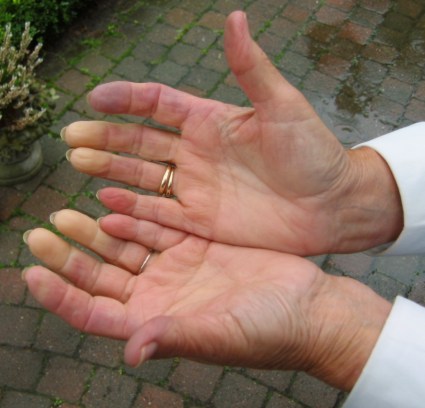Raynaud's disease (patient information): Difference between revisions
No edit summary |
|||
| Line 20: | Line 20: | ||
{{EJ}} | {{EJ}} | ||
== | ==Overview== | ||
Raynaud's disease refers to a disorder in which the fingers or toes suddenly experience decreased blood circulation. Usual triggers include cold stimulation and [[stress]]. Patients' finger or toes may turn pale or white and then blue, feeling numb, cold, or painful. Skin [[ulcer]]s may appear in severe cases. The doctor may diagnose your Raynaud's disease by medical history, [[physical examination]] and cold stimulation test. Maintain a good life-style and avoid [[trigger]]s are very important for patients with Raynaud's disease. Treatment opinion includes [[medication]]s and [[surgery]]. Many cases of Raynaud's disease carry good outcomes. | Raynaud's disease refers to a disorder in which the fingers or toes suddenly experience decreased blood circulation. Usual triggers include cold stimulation and [[stress]]. Patients' finger or toes may turn pale or white and then blue, feeling numb, cold, or painful. Skin [[ulcer]]s may appear in severe cases. The doctor may diagnose your Raynaud's disease by medical history, [[physical examination]] and cold stimulation test. Maintain a good life-style and avoid [[trigger]]s are very important for patients with Raynaud's disease. Treatment opinion includes [[medication]]s and [[surgery]]. Many cases of Raynaud's disease carry good outcomes. | ||
Revision as of 20:30, 1 August 2011
For the WikiDoc page for this topic, click here
| Raynaud disease | ||
 | ||
|---|---|---|
| Hands with Raynaud's disease | ||
| ICD-10 | I73.0 | |
| ICD-9 | 443.0 | |
| OMIM | 179600 | |
| DiseasesDB | 11186 | |
| MedlinePlus | 000412 | |
| eMedicine | med/1993 | |
| MeSH | C14.907.744 | |
Editor-In-Chief: C. Michael Gibson, M.S., M.D. [1]; Jinhui Wu, MD
Please Join in Editing This Page and Apply to be an Editor-In-Chief for this topic: There can be one or more than one Editor-In-Chief. You may also apply to be an Associate Editor-In-Chief of one of the subtopics below. Please mail us [2] to indicate your interest in serving either as an Editor-In-Chief of the entire topic or as an Associate Editor-In-Chief for a subtopic. Please be sure to attach your CV and or biographical sketch.
Overview
Raynaud's disease refers to a disorder in which the fingers or toes suddenly experience decreased blood circulation. Usual triggers include cold stimulation and stress. Patients' finger or toes may turn pale or white and then blue, feeling numb, cold, or painful. Skin ulcers may appear in severe cases. The doctor may diagnose your Raynaud's disease by medical history, physical examination and cold stimulation test. Maintain a good life-style and avoid triggers are very important for patients with Raynaud's disease. Treatment opinion includes medications and surgery. Many cases of Raynaud's disease carry good outcomes.
How do I know if I have Raynaud's disease and what are the symptoms of Raynaud's disease?
Raynaud's disease usually affect the fingers and toes, beginning in one finger or toe and moving on to other fingers or toes. The attacks can last from less than a minute to several hours. Usual signs and symptoms are:
Who is at risk for Raynaud's disease?
The underlying cause of Raynaud's disease is not clear. Clinical studies demonstrate the following factors may be associated with the onset of this disease.
- Cold temperatures
- Stress
- Family history of Raynaud's disease
- Female gender
- Age between 15~30
How to know you have Raynaud's disease?
- Medical history and physical examination
- Cold stimulation test: Cold stimulation can be used to trigger Raynaud's disease. During this test, your hands may be placed in ice water or exposed to cold air to trigger an episode of Raynaud's disease. Then, the doctor measures the time for your fingers to return to their original temperature. If your fingers appear color changes and feel numb or pain, and the time to return to original temperature is longer than 20 minutes, your doctor may consider Raynaud's disease.
When to seek urgent medical care?
Call your health care provider if symptoms of Raynaud's disease develop.
Treatment options
Raynaud's disease can not cure. The goal of treatment is to reduce the number and severity of attacks.
- Change life-style, avoid triggers.
- Avoid cold stimulation
- Control stress
- Avoid drugs that may increase blood vessel spasm, such as beta blockers, birth control pills and cold drugs including pseudoephedrine.
- Medications: Meidcations may widen blood vessels and promote circulation. Usual medications include:
- Calcium channel blockers, such as nifedipine, amlodipine and felodipine
- Alpha blockers, such as prazosin and doxazosin.
- Vasodilators, such as nitroglycerin cream, prostaglandins
- Sympathectomy, cutting sympathetic nerves in your hands and feet, may be helpful for patients with severe Raynaud's disease. The surgery may interrupt the exaggerated response and reduce the frequency and duration of attacks.
- Amputation: This is rare. When the blood supply of your finger or toe has been completely blocked and the tissue has developed gangrenea, amputation may be considered.
Diseases with similar symptoms
- Raynaud phenomenon (Secondary Raynaud)
Where to find medical care for Raynaud's disease?
Directions to Hospitals Treating Raynaud's disease
Prevention of Raynaud's disease
- Avoid cold stimulation, take a good care of your hands and feet.
- Control stress
- Quit smoking
- Do some regular exercises
What to expect (Outlook/Prognosis)?
Generally, prognosis of Raynaud's disease is good. The most important thing is to avoid triggers.
Copyleft Sources
http://www.mayoclinic.com/health/raynauds-disease/DS00433/DSECTION=symptoms
http://www.nhlbi.nih.gov/health/dci/Diseases/raynaud/ray_what.html
http://www.skinsight.com/adult/raynaudsDisease.htm